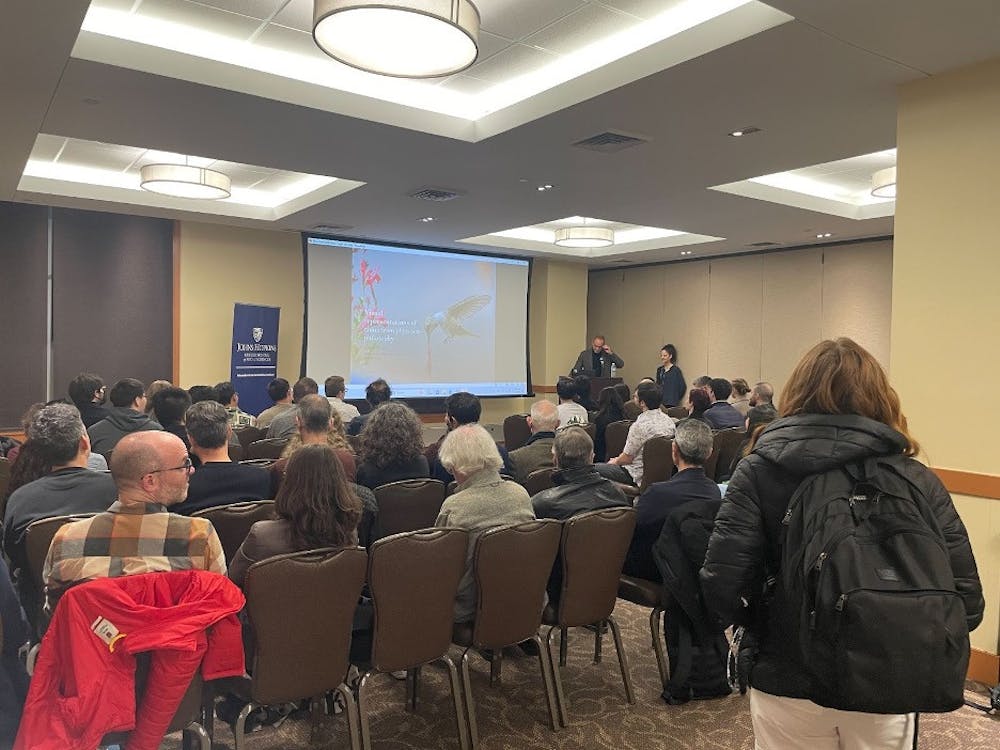The Alexander Grass Humanities Institute (AGHI) hosted its first New Faculty Lecture on Thursday, Nov. 2 with Jenann Ismael, the William H. Miller III Professor of Philosophy at Hopkins. Previously a philosophy professor at Columbia University and an affiliate of Columbia University’s Zuckerman Institute, Ismael gave a talk titled “Time and Visual Imagination: From Physics to Philosophy.”
The talk included both an overview of physics principles as well as a proposal for an alternate interpretation of time. Ismael began by recognizing the significance of illustrations as an aid for people to visualize the abstract laws of nature. She acknowledged the human capacity for pattern recognition, which plays a crucial role in physics concepts spanning from Newton’s Laws of Motion to waves and electromagnetism.
Ismael then introduced a vision of time different from the classical view of seeing the universe as a dynamic process.
“A new vision of time took shape with relativity, and [...] presented space and time together as part of the four-dimensional manifold,” she said.
Subsequent theories of time emerged to reconcile with physics. One group mentioned was the block universe theory enthusiasts, who describe the universe as a four-dimensional block.
In an interview with The News-Letter, Rahul Jakati, a junior majoring in Writing Seminars, expressed that the discussion of time was one of his main motivations for attending this event.
“I do a lot of memory research and time is especially relevant to memory. This event allow[ed] me to branch out to subjects I am interested in beyond my major,” he said.
On the subject of visual representations, Ismael noted the significance of diagrams to describe higher-order patterns not immediately visible to people. However, she explained that a philosophical controversy emerges from the dimensional application to time, as in special relativity, time is treated explicitly as a dimension along a t-axis.
“In reality, there is no external dimension to create a point of view from which time can be seen since there is only space-time itself,” Ismael said.
In the interview, Jakati expressed that he finds the visualization of time to be incredible.
The pictorial representations of time [are fascinating]. I am taking a class right now on photography in science and medicine and we talk about how photographs, images [and] diagrams could be arguments in and of themselves. I think that is echoed in what Professor Ismael mentioned,” he said.
Alternatively, Ismael suggested studying time from our direct individual perceptions, offering the idea that one should not be looking at time but living through it. She this perception of time through an example with music.
“Suppose you are listening to music for the first time, as each note progresses, your memory and expectation builds, recognizing the sounds as a pattern of temporal musicality, a melody,” she said. “Without a listening mind, there would be no resonance.”
Ismael likened experiences a piece of music unfolding to experiencing life unfolding. She proposed that time must be imagined from the inside to be recognizable. Because of this subjective nature of time, she argued that time is a manufactured entity.
“The temporality of experience, the sense of passage, flux that make time seem so different [from] space are not properties of time itself, but qualities evoked in the mind of the agent that lives through it,” she said.
In an interview with The News-Letter, Ryan Lu, a freshman majoring in Computer Science, talked about how listening to Ismael’s lecture has changed his perception of time.
“Before this lecture, I thought of time as a fixed concept that could be perfectly modeled by physics,” he said. “Now I think that it may be relevant to put the ‘self’ into the equation and start from within to understand the world instead of defaulting to a top-down perspective.”
Jakati echoed similar sentiments and discussed his takeaways from the lecture.
“After this talk, I really got a deeper understanding of the meaning of time, the ontology of it, the epistemology of it and how one can track time from different viewpoints,” he said.





